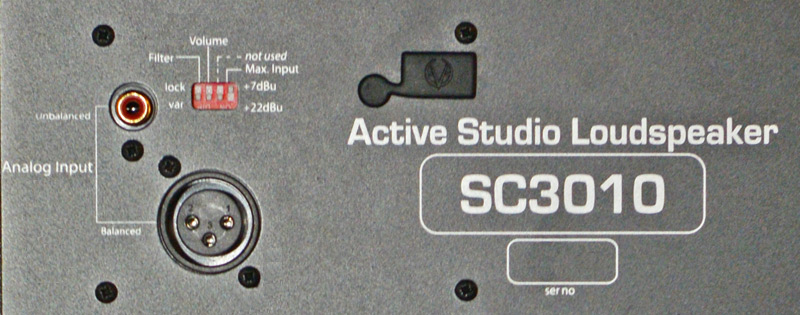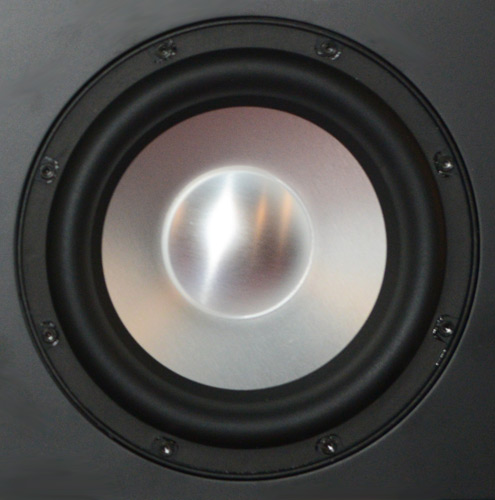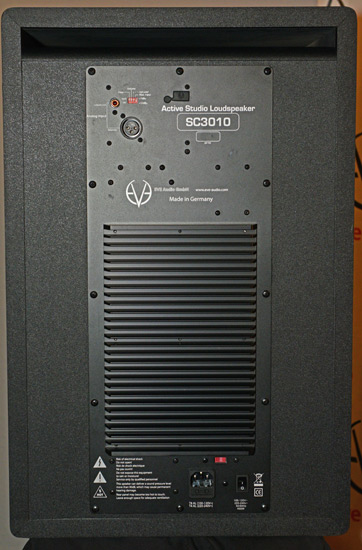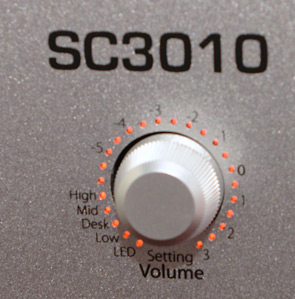EVE Audio SC3010 / SC3012
Revised version of the active three-way main monitors
Author and photos: Peter Kaminski
We have already tested a whole range of EVE Audio loudspeakers, such as various nearfield and desktop monitors, as well as the SC2070, SC3070, and SC4070 midfield speakers (on our German portal proaudio.de only). In this test, however, we’re going a little bigger, as we want to introduce the SC3010 and SC3012 main studio monitors. These have been in the EVE Audio product portfolio since 2013, but they received an update in summer 2024, and we want to take it as an opportunity to present the studio monitors in more detail.Concept and technology
The SC3010 and SC3012 are active three-way monitors with10-inch and 12-inch woofers, respectively, as the name suggests,. The SC3010 measures 380 x 580 x 440 and the SC3012 435 x 650 x 490 mm. With a weight of 37kg for the SC3010 and 44kg for the SC3012, you’ll need to make sure that you have a stable support or monitor stand. The design of the SC3010 and SC3012 continues the usual design language of the EVE Audio speakers. Let’s first take a look at the speaker driver concept. [DSC 5649]
The SC3010 and SC3012 use identical midrange and high-frequency drivers. In all EVE Audio loudspeakers, air motion transformer are used as high-frequency drivers. This is also the case with these main monitors, where larger RS6 air motion transformers (AMT) are used that have 2.5 times the surface area of the usual air motion transformer drivers and are only installed in these main monitors. The use of the larger drivers was pushed because the aim was to achieve a lower crossover frequency between midrange and high frequency drivers. The crossover frequency between the midrange and high-frequency drivers is relatively low with 1.8 kHz for the SC3010 and SC3012. These air motion transformers weredeveloped and manufactured in-house by EVE Audio.
A 5-inch driver (130 mm) is used as the midrange driver, which is already relatively large for the intended use. However, it is tuned as a pure midrange driver and is not a bass/midrange speaker. The size ensures that little energy is required for excursion, which also minimizes distortion. The cone material used is Rohacell with a glass fiber coating, which makes the cone light and stable.
The woofer was updated in the summer of 2024. Previously, a Honeycomp cone was used that was coated with glass fiber on both sides. A multi-layer aluminum cone is now used, which is coated with plastic to tune resonances lower.
The woofers have a large excursion and require corresponding driving power. Identical amplifiers are installed in the SC3010 and SC3012. Two 400-watt Hypex amplifier modules are used for the woofer in bridge mode. This means that 800 watts of power are available. The Hypex modules are designed as Class D amplifiers. The mid-range and high-frequency drivers are each driven by a 250-watt Hypex amplifier module. A power supply unit with a nominal output of 1,200 watts is installed to ensure that sufficient energy is available for the output stages, even at peak power levels.
The front consists of a 25mm thick multiplex panel to prevent the front from vibrating. The cabinet is constructed from 22mm MDF. The midrange and high-frequency drivers are mounted on a 10mm thick aluminum plate. This can be rotated by 90 degrees so that the loudspeakers can also be operated horizontally, and the mid/high frequency drivers can be arranged vertically - i.e. one above the other. This guarantees a stable stereo image. The screws do not have to be removed completely to turn the plate. It is sufficient to loosen the screws.
The bass reflex ports of the SC3010 and SC3012 are located at the rear. It is always a common question to determine whatis better. In two-way systems, front-facing bass reflex ports have the disadvantage that signal components from the rear of the woofer reach the front, and interference with a time delay. This can be avoided if the opening points to the rear. For this reason, the openings in EVE Audio’s two-way systems are located at the rear, and this has also been adopted for the three-way systems. However, front-facing bass reflex ports have another disadvantage, namely, airflow noise emitted to the front, which can be very strong in some cases, and the strong airflow to the front can also be annoying. The argument that speaker systems with a rear-facing bass reflex port cannot be placed close to a wall is incorrect. The wavelength range in which the bass reflex tubes operate is so long that it practically makesno difference how close you can place the speaker to the wall.
Incidentally, the SC3010 and SC3012 can also be integrated into the wall. All that is required is to seal the bass reflex openings with foam and ensure that there is sufficient air circulation at the rear to dissipate the heat lost from the power amplifiers.
Connections and technical data
The frequency range of the SC3010 is specified by the manufacturer as 29Hz to 25kHz and 25Hz to 25kHz for the SC3012. The crossover frequency from the bass to mid-frequency driver is 240Hz for the SC3010 and 220Hz for the SC3012. The maximum sound pressure level is specified as 126dBspl for the SC3010 and 130dBspl (@ 1m) for the SC3012. The speakers also have a protective limiter. Chips from the manufacturer Burr Brown are used as A/D converters.
The two analog inputs have an impedance of 10 kiloohms. Either an RCA (unbalanced) or a 3-pin XLR socket (electronically balanced) is available as an input. The maximum input level can be switched between +7 and +22 dBu, which corresponds to the usual nominal levels of -10 dBV or +4 dBu with corresponding headroom.
The power supply unit offers an operation at mains voltages of 100 ... 120 and 220 ... 240 volts (50/60Hz) with automatic selection of the voltage range.
Operation

In addition to the input sockets, there are three small DIP switches on the rear of the loudspeaker for selecting the input level and for fixing the current setting of the filters and the input gain too.
On the front, the Smart Knob with LED ring – which is foundin all EVE Audio speakers - can be used to adjust the low (< 300 Hz) and high shelf filters (> 3 kHz) and mid filters (1 kHz) by -5 and +3 dB, respectively. Other parameters include a desk filter boost (80 Hz, 0 ... +3 dB) and desk filter cut (160 Hz, -5 dB ... 0 dB), LED contrast and, of course, the input gain (infinite to +6 dB).
Another interesting feature is that the LED ring begins to flash when the input is overloaded, regardless of the gain setting. The SC3010 and SC3012 also offer a so-called save fade. In the event of a power failure or switch-on, the level is slowly increased so that the user still has the option of reducing or muting the level if necessary.
Practice
In the test studio, both the SC3010 and SC3012 were set up simultaneously next to each other as a stereo pair. We had the opportunity to compare the SC31010 and SC3012 directly via a switch.
The monitors are characterized by a very high level of precision in reproduction. The tuning is very successful. No abnormalities or phase problems are audible even at the crossover frequencies between the drivers. The SC3010 and SC3012 offer a very high level of naturalness and neutrality. Transients are also passed through nicely. You can clearly hear the extension of the frequency range downwards with the SC3012; however,this is merely an extension and not a boost effect. If you listen to the SC3010 for a longer period of time without switching, you don’t get the impression that anything is missing in the lower bass range.
In a blind test against other monitors with classic tweeters, you won’t be able to tell whether an Air Motion Transformer driver is being used or not with this level of playback precision. Sometimes, negative comments are made about AMTs. It has to be said that all speakers need to be well tuned, of course; however, but this is particularly important when using AMTs and the EVE Audio SC3010, and SC3012 have really achieved this perfectly.
Conclusion
The list price quoted by the manufacturer for the SC3010 is around 4,000 euros / 5,600 US$ per unit and for the SC3012 around 5,200 euros / 7,360 US$. In terms of size and performance, the SC3010 and 3012 are aimed at medium-sized and larger mixing and mastering studios, as well as film production studios.
The quality of the SC3010 and SC3012 convinced me across the board, and they can be used for all musical genres, from classical to heavy metal and film music without any restrictions. The drivers, amplifier, and power supply offer sufficient reserves for even the most extreme signals and productions.
 How to resolve AdBlock issue?
How to resolve AdBlock issue? 


